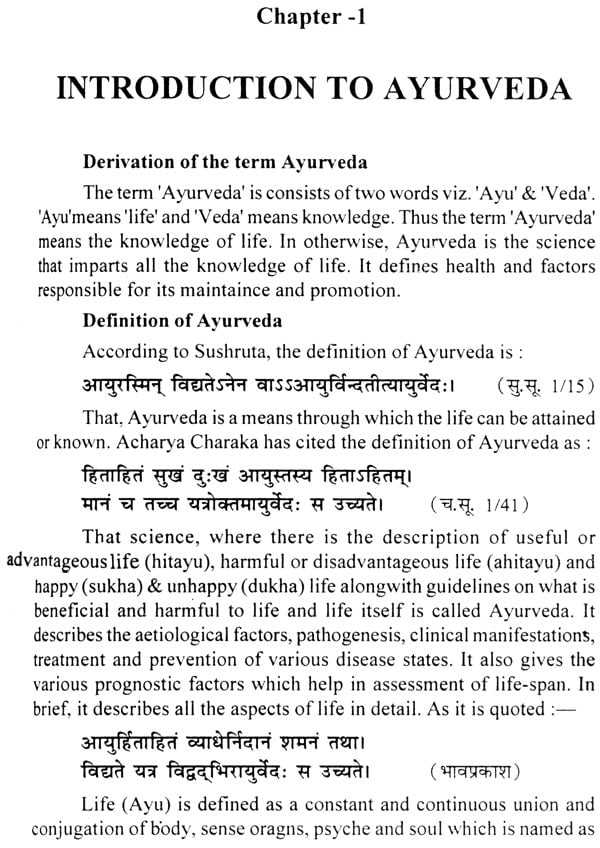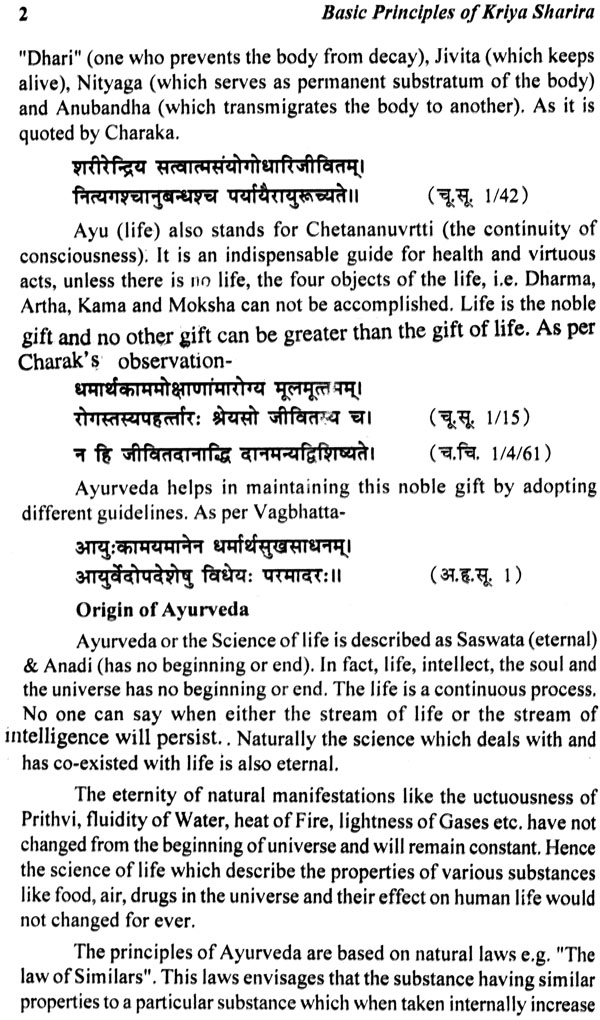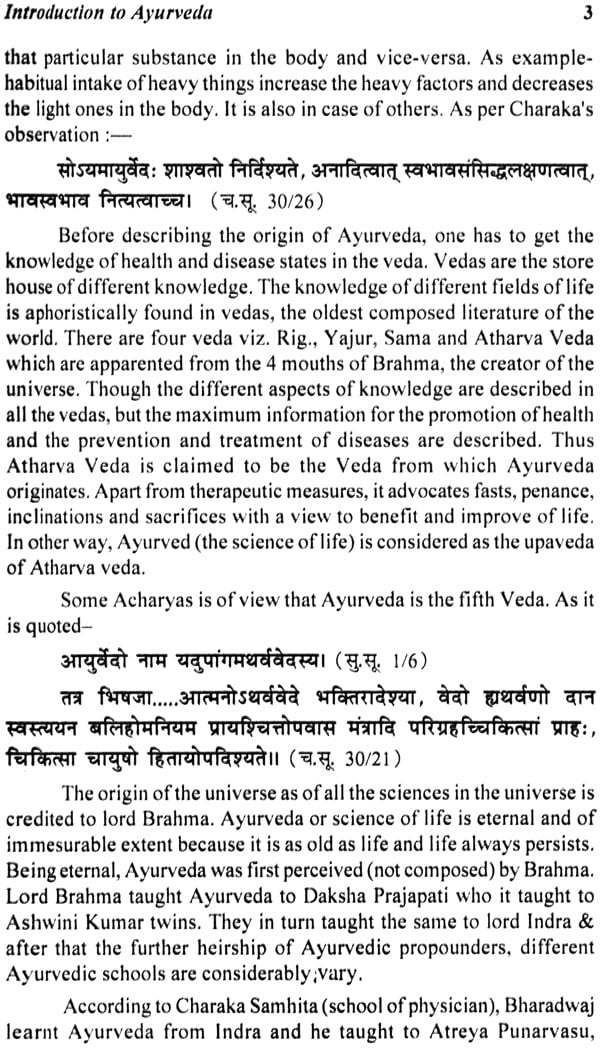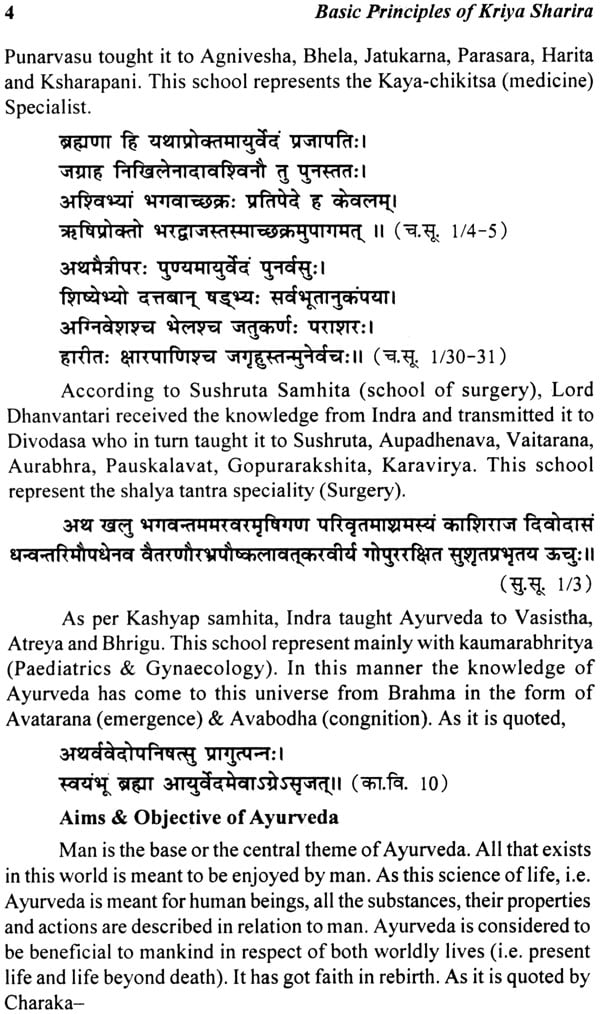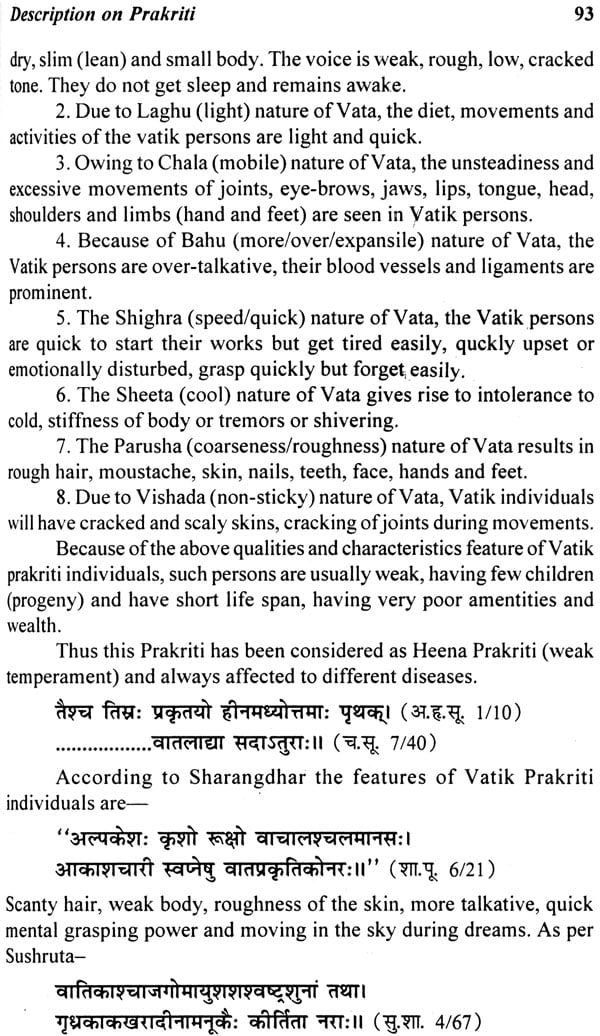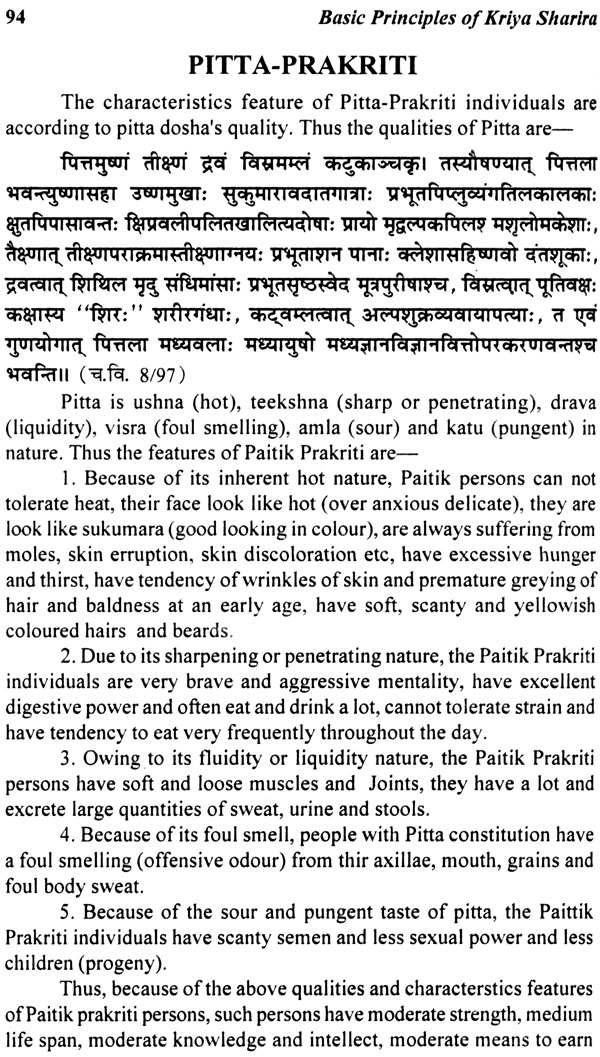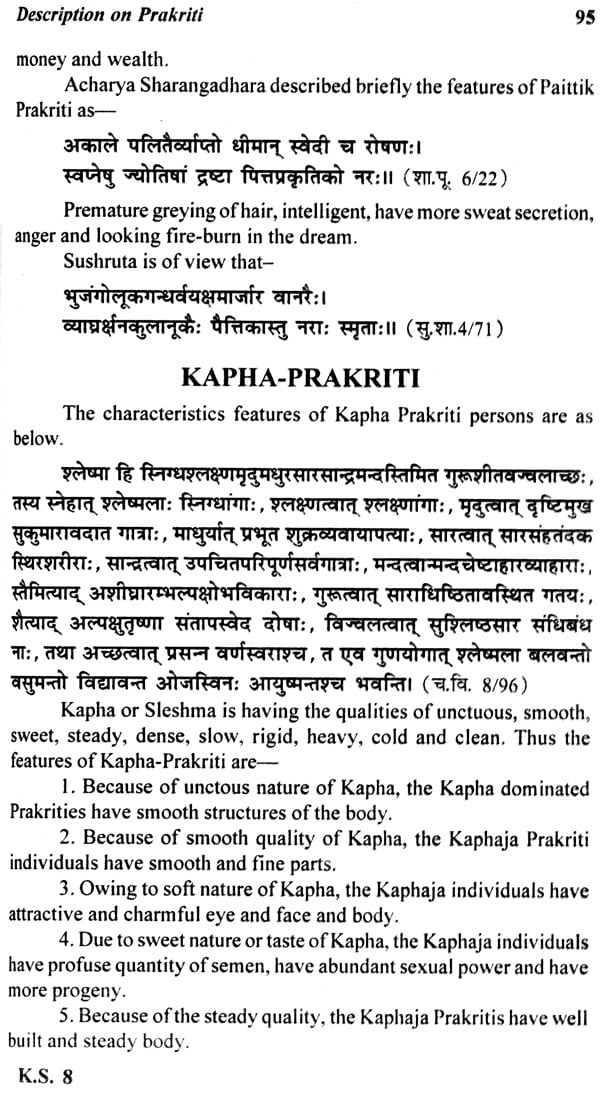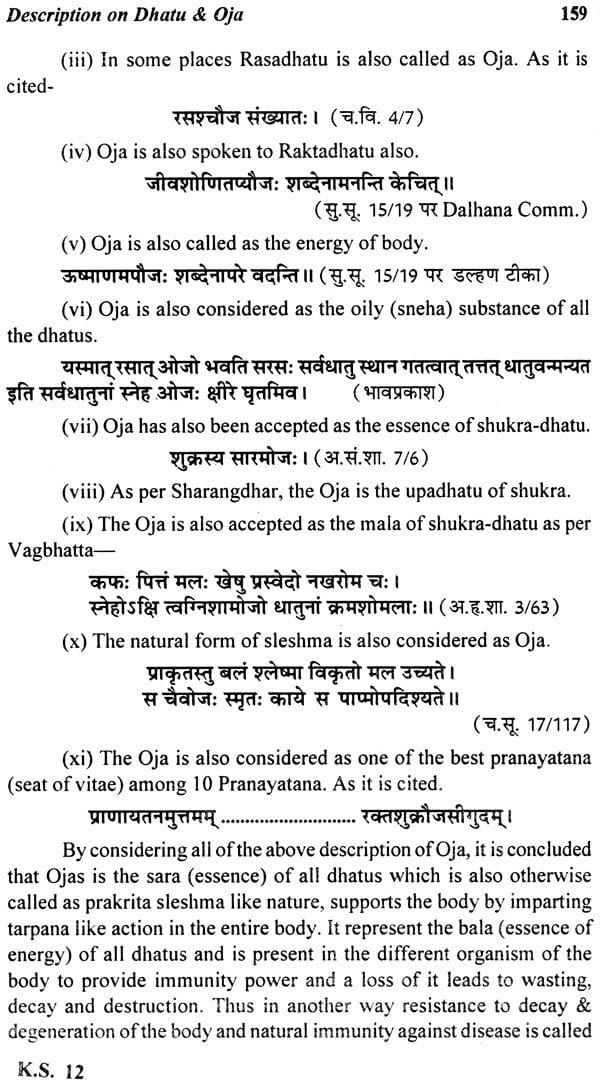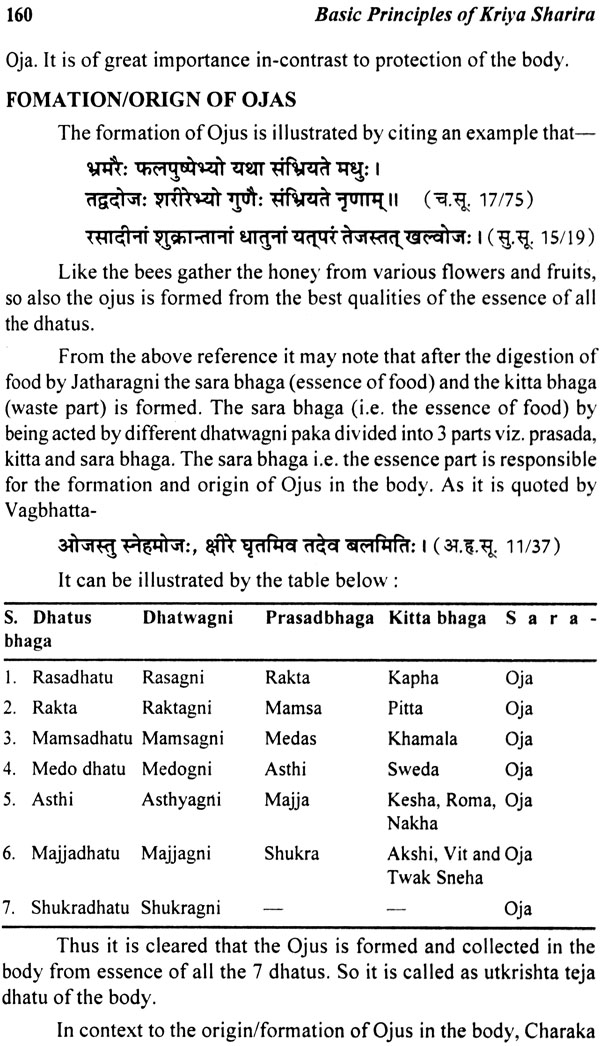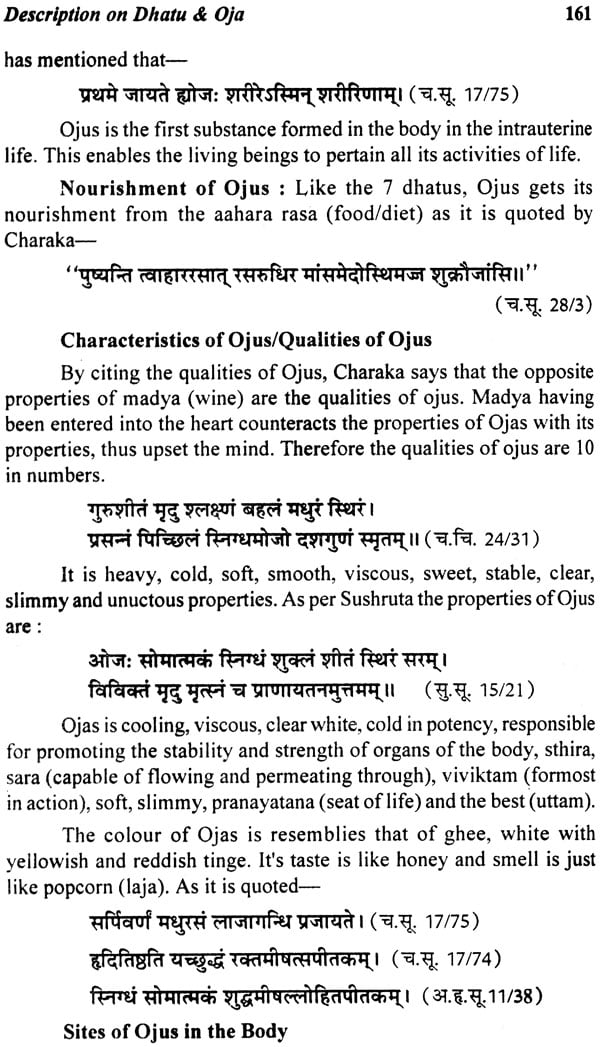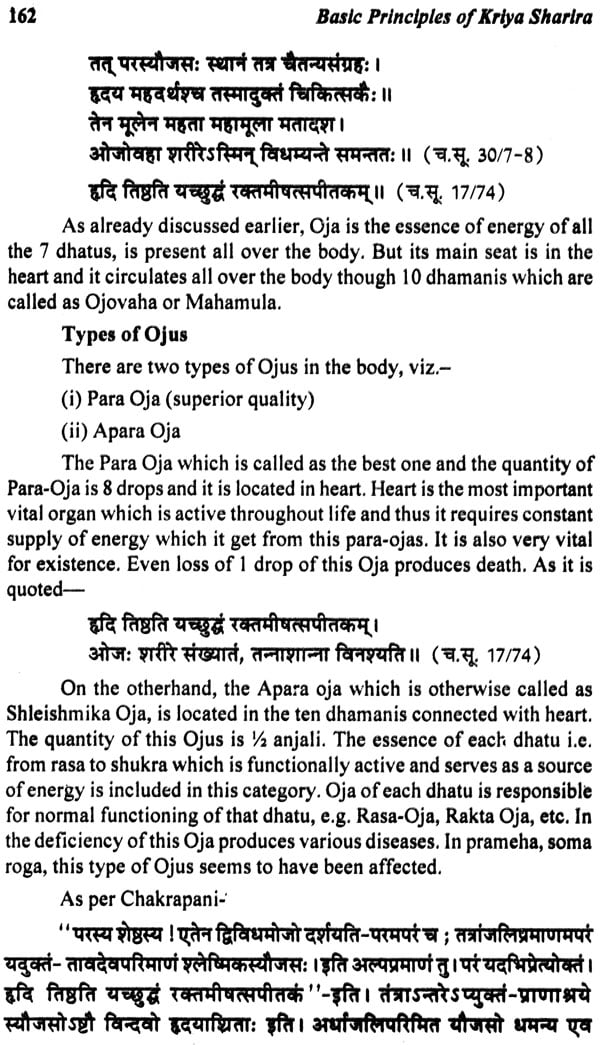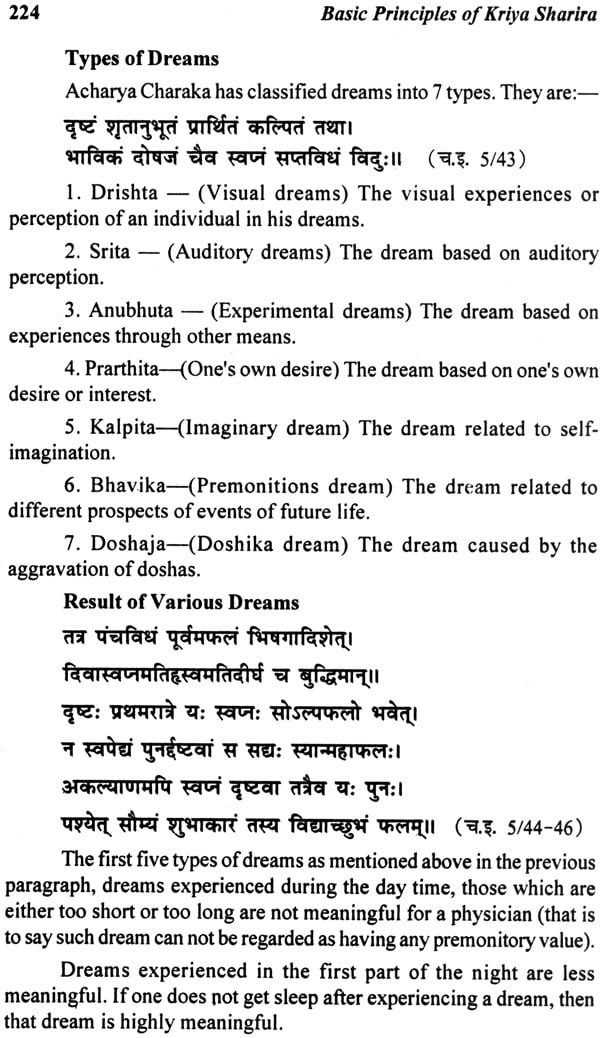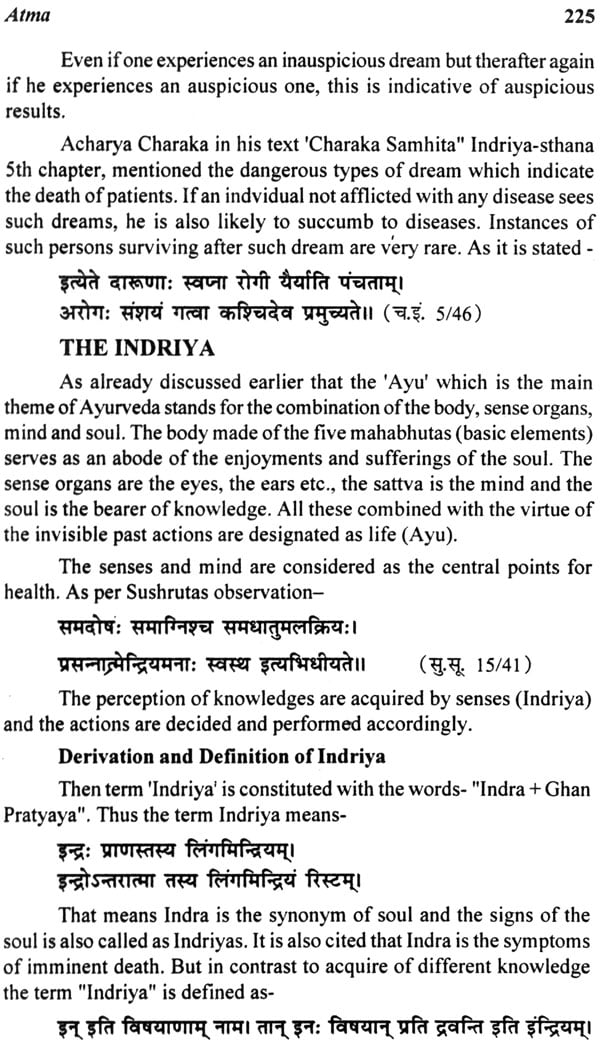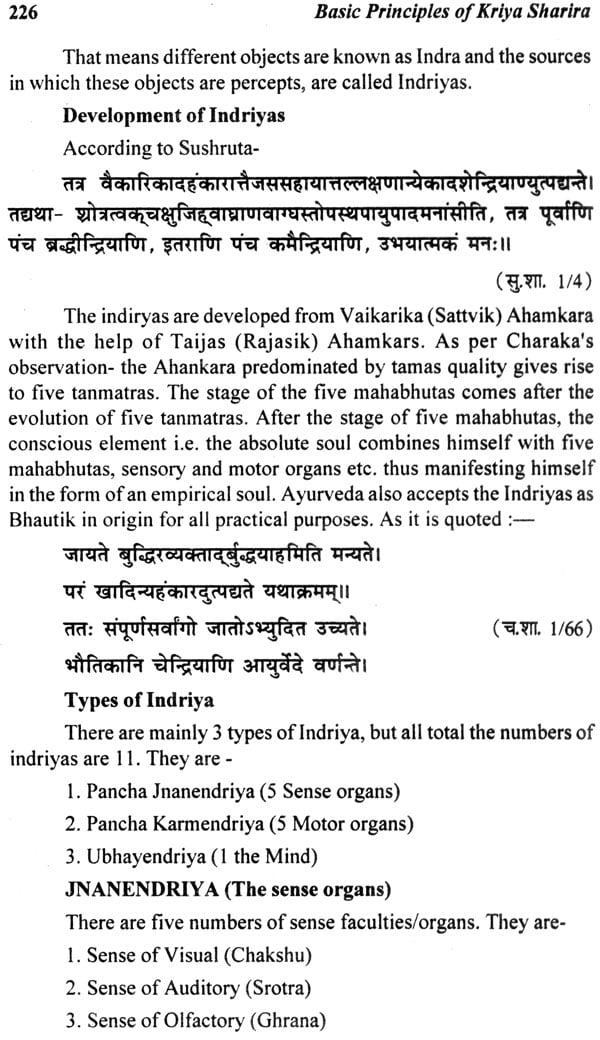
Basic Principle of Kriya Sharira: (A Treatise on Ayurvedic Physiology)
Book Specification
| Item Code: | IDJ024 |
| Author: | Dr. Srikant Kumar Panda |
| Publisher: | CHAUKHAMBHA ORIENTALIA, Delhi |
| Language: | English |
| Edition: | 2016 |
| ISBN: | 8189469088 |
| Pages: | 230 |
| Cover: | Paperback |
| Other Details | 8.5 inch X 5.5 inch |
| Weight | 260 gm |
Book Description
Preface:
This book entitled "Basic Principles of Kriya - Sharira" is specially written for Ayurvedic graduate (BAMS) students keeping in view the CCIM syllabus. The brief sketch on different subject matter of Ayurvedic Physiology has been enumerated in this treatise in a scholar friendly manner. There are many books in the field of Kriya - Sharira available in Hindi version. It is perhaps the first English version on Ayurvedic Physiology. Moreover due to science based students taking admission in different Ayurvedic colleges in the country, it creates difficult for them to understand the subject matter easily.
Apart from prescribed topics approved by CCIM, some other aspects of Ayurvedic Physiology viz. the applied physiology of different Doshas for the production of diseases of varying nature and also some general therapeutic measures has been visualized in this book. This book is also designated to be useful for Ayurvedic Post - graduate students and aspirants for getting P.G. in different reputed institutions in the country.
I hope that this book will be very popular amongst the students and teachers to fulfil their aspirations. Finally, I humbly welcome the suggestions, improvements and critical remarks from any part so that it can carry them in future revision.
Dr. Srikant Kumar Panda
Author
ABOUT THE AUTHOR
Dr. Srikant Kumar Panda was born on 6th April 1970 in Kamakshya Nagar Sub-division of Dhenkanal District in Orissa. He had obtained his B.A.M.S. Degree in K.A.T.S. Govt. Ayurvedic College, Ankushpur, Berhampur, Ganjam, Orissa with distinction. He has one his M.D. & Ph.D. (Ay.) study from National Institute of Ayurveda, Jaipur, Rajasthan(only National Institute under Govt. of India) under the Guidance of Renowned Guru Prof. Dr. Om Prakash Upadhyaya, Professor & HOD Deptt. of Basic Principles, N.I.A. At present he is working as a lecturer in the P.G. Deptt. of Kriya - Sharira in A & U Tibbia College, Govt. of N.C.T. Delhi under University of Delhi. Formerly, he had worked as lecturer in G.B. Ayurvedic College, M.D. University, Rohtak, Haryana.
ABOUT THE BOOK
This book on "Basic Principle of Kriya-Sharira" basically a treatise on Ayurvedic physiology mainly designed as per CCIM Syllabus for U.G. & P.G. studies and is scholar friendly. The subject matters that are described in this book are briefed and well established. A new dimension of applied physiology of different doshas & their produced diseases and also the theraputic measures applied for checking them has been enumerated. Thus, it will help the scholars, teachers & physician a scientific idea for further observation.
| Chapter-I | |
| Introduction to Ayurveda | 1-8 |
| Derivation and Definition of Ayurveda, Origin of Ayurveda, Aim and Objective of Ayurveda, Scope and Branches of Ayurveda, Health and Arogata in Ayurveda | |
| Chapter-II | |
| Description on Shariram | 9-28 |
| Definition and Importance of Sharira Sastra, Derivation and Definition of kriya-Sharira, Derivation & Definition of Sharira, Synonyms of the term Sharira, Definition of Kriya, Basic Principles of Sharira in Ayurveda, Purusha, Classification of Purusha, Composition of body (Dosha Dhatu Mala Mulatmaka Shariram), Panchamahabhuta theory in Ayurveda | |
| Chapter-III | |
| Description on Dosha | 29-78 |
| Definition and History of Dosha, Numbers of Dosha, Importance of Tridosha, Genesis of Dosha from Panchamahabhuta, Mutual Relationship between Triguna and Tridosha, Mutual relationship between Loka (universe) and Purusha (man), Brief sketch on Tridosha Psychic Dosha (Manasika), Role of Dosha in causation of disease, Increase and decrease state of Dosha, Clinical manifestation of increased Dosha, Signs & symptoms due to increased Vata, Signs and Symptoms due to increased Pitta, Signs & Symptoms due to increased Kapha, Clinical manifestation of decreased dosha, Signs and symptoms due to decreased Vata, Signs and symptoms due to decreased Pitta, Signs and symptoms due to decreased Kapha. | |
| VATA DOSHA | 45-58 |
| Etymology & Definition of Vata, Synonyms of Vata, Panchabhautik constitution of Vata, Quality of Vayu, Physical Characteristics of Vata, Sites of Vata in the body, Varieties of Vata in the body, Physiological actions of Vata. | |
| Prana Vayu- Sites of Prana Vayu, Characteristics/Nature of Prana Vayu, Functions of Prana Vayu, Specific functions of Prana Vayu, Applied physiology of Prana Vayu. Udana-Vayu- Location of Udana Vayu, Function of Udana Vayu, specific functions of Udana Vayu, Applied Physiology of Udana Vayu. Samana-Vayu- Location of Samana Vayu, Functions of Samana-Vayu, Special role of Samana-Vayu, Applied Physiology of Samana Vayu. Vyana-Vayu- Location of Vyana Vayu, Functions of Vyana-Vayu, Applied Physiology of Vyana Vayu. Apana-Vayu-Sites of Apana Vayu, Functions of Apana Vayu, Applied physiology. | |
| PITTA DOSA | 58-68 |
| Etymology & Definition of Pitta, Pancha bhautik constitution of Pitta, Qualities of Pitta, Physical characteristics of Pitta, Location of Pitta in the body, Specific sites of Pitta, Physiological function of Pitta, Types of Pitta. Ranjaka-Pitta-Sites of Ranjaka Pitta, Functions of Ranjaka Pitta. Pachaka Pitta- Sites of Pachaka Pitta, Functions of Pachaka Pitta. Alochaka Pitta- Sites of Alochaka Pitta, Functions of Alochaka Pitta, Types of Alochaka-Pitta, Chakshurvaisheshika, Budhi vaisheshika. Sadhaka Pitta- Sites of Sadhaka Pitta, Functions of Sadhaka Pitta. Bhrajaka Pitta-Sites of Bhrajaka Pitta, Functions of Bhrajaka Pitta. | |
| KAPHA DOSHA | 68-78 |
| Etymology & Definition of Kapha, Synonym of Kapha. Panchabhautik constitution of Kapha, Qualities of Kapha, Physical Characteristics of Kapha, locations of Kapha in the body, Physiological actions of Kapha, Types of Kapha in the Body. Avalambaka Kapha-Sites of Avalambaka Kapha, Functions of Avalambaka Kapha. Kledaka Kapha- Sites of Kledaka Kapha, Functions of Kledaka Kapha. Bodhaka Kapha- Sites of Bodhaka Kapha, Functions of Bodhaka Kapha. Tarpaka Kapha- Sites of Tarpaka Kapha, Functions of Tarpaka Kapha. Sleshmaka Kapha- Sites of Sleshmaka Kapha, Functions of Sleshmaka Kapha, | |
| Chapter-IV | |
| Description on Kriya-Kala | 79-88 |
| Definition of Kriya Kala, Stages of Kriya Kala, 1st stage of Kriya Kala (Sanchayavastha), Signs & Symptoms of Kriya-Kala, 2nd stage of Kriya-Kala (Prakopavastha), Causes of Dosha-Prakopa, Causes of Vata Prakopa, (a) Dietery causes (b) Behaviour causes (c) Seasonal causes, Causes of Pitta-Prakopa, (a) Dietery causes (b) Behavioural causes (c) Seasonal causes, Causes of Kapha Prakopa, (a) Dietery causes (b) Behavioural causes (c) Seasonal causes Signs & Symptoms of Dosha Prakopa, 3rd Kriya-Kala (Prasaravastha), Symptomtology of spreaded dosha, Rules for treatment in 3rd Kriya-Kala, 4th stage of Kriya-Kala (Sthanasansrayavastha), Manifestation of disorders due to localisation of dosha in different parts of the body, 5th stage of Kriya-Kala (Vyaktavastha), 6th stage of Kriya-Kala (Bhedavastha). | |
| Chapter-V | |
| Description on Prakriti (Temperament) | 89-105 |
| Definition of Prakriti, Origin of prakriti, Factors determing prakriti, Classification of prakriti, Description of Deha prakriti, (shareerika prakriti), Vata prakriti, Pitta prakriti, Kapha-prakriti, Dwandaja prakriti, Sama (Tridoshta) prakriti, Description of Bhautik prakriti Parthiva prakriti, Nabhasa prakriti, Table showing the featuers of different prakriti, Utility of prakriti examination, Description of Manashika or Sattwika prakriti (psychological temparament), Features of sattivik prakriti, Classification of sattivik prakriti, Brahma sattva, Arsha Sattva, Endra Sattva, Yamya Sattva, Varcuna Sattva, Kaubera Sattva, Gandharva Sattva, Features of Rajas prakriti, Classification of Rajas prakriti, Asura Sattva, Rakshasa Sattva, Paishacha Sattva, Sarpa Sattva, Preta Sattva, Shakuna Sattva, Features of Tamas prakriti, Classification of Tamas prakriti, Pashava Sattva, Masttachya Sattva, Vanaspatya Sattva. | |
| Chapter-VI | |
| Description on Agni | 106-113 |
| Definition, Types of Agni, Definition of Jatharagni, Sites of Jatharagni, Functions of Jatharagni. Bhootagni- Types of Bhootagni, Functions of Bhootagni, Sites of Bhootagni. Dhatwagni- Types of Dhatwagni, Functions of different Dhatwagni, | |
| Chapter-VII | |
| Description on Dhatu and Oja | 114-169 |
| Derivation and Definition of Dhatu, Types of Dhatu, Genesis of Dhatu from Mahabhuta, Formation & Nourishment of Dhatus, Different theories for the formation & nourishment of dhatus, Ksheera Dadhi Nyaya, Kedari Kulya Nyaya, Khale-Kapota Nyaya, Ekakala Dhatu Poshana Nyaya. Rasa Dhatu- Derivation & Definition, Formation of Rasa-dhatu, Location of Rasa, Physical properties of Rasa, Quantity of Rasa, function of Rasa. Description of Ashtavidha Sara Purusha, Characterstics features of Twak Sara Purusha, Upadhatu of Rasa, Features of Rasa Kshaya, Features of Rasa Vriddhi, Diseases of Rasa (Rasaja Vikara), General measures for Rasaja Vyadhi, Rasavaha Srota, Importance of Rasa in the body. Rakta Dhatu- Synonyms of Rakta, Formation of Rakta Dhatu, Characteristic features of pure blood, Panchabhautik features of blood, Functions of Rakta, Quantity of Rakta in the body, Characteristics of individual having pure blood, Characteristic features of Rakta Sara Purusha, Signs & Symptoms of Rakta Kshaya, Signs & Symptoms of Rakta-Vriddhi, Diseases of Rakta (Raktaja Roga), General measures of Raktaja Roga, Raktavaha srotas, Upadhatu of Rakta, Mala of Rakta. Mamsa Dhatu- Formation of Mamsa dhatu, Physical characteristics of Mamsa dhatu, Description of Peshi, Quantity of Mamsa dhatu, Functions of Mamsa-dhatu, Characteristic features of Mamsa-Sara Purusha, Signs & Symptons of Mamsa-Kshaya, Signs & Symptoms of Mamsa-vriddhi, Diseases of Mamsaja disorder (Mamsa doshaja vikara), Mamsavaha srotas, Mamsadhara Kala, Upadhatu of Mamsa, Mala of mamsa. Medo Dhatu- Formation of Medo-dhatu, Physical characters of Meda-dhatu, Quantity of Medas, Functions of Medo-dhatu, Characteristics features of Medo-Sara Purusha, Signs & Symptoms of Medo-Kshaya, Signs & Symptoms of Medo-Vriddhi, Features of emaciation of body, Medoja disorders, Medo-Vaha srotas, Medo-dhara Kala, Upadhatu of Medas, Mala of Medo-dhatu. Asthi Dhatu- Formation of Asthi-dhatu, Physical Characters of Asthi-dhatu, Numbers of Asthi in the Body, Types of Asthi, Functions of Asthi dhatu, Characteristics features of Asthi-Sara-Purusha, Signs & Symptoms of Asthi-kshaya, Disorders of Asthi dhatu, Asthi-Vaha Srotas, Mala of Asthi-dhatu, Upadhatu of Asthi dhatu. Majja Dhatu- Formation of Majja dhatu, Physical properties of Majja-dhatu, functions of Majja -dhatu, Quantity of Majja-dhatu, Characteristics features of Majja-Sara Purusha, Signs & Symptoms of MajjaKshaya, Signs & Symptoms of Majja-Vriddhi, MajjaVaha srotas, Disorder of Majja-dhatu, Upadhatu of Majja, Mala of Majja dhatu. Shukra Dhatu- Importance of Shukra-dhatu in the Body, Nature of Shukra, Formation of Shukra dhatu, Location of Shukra in the Body, Existence of Shukra in female & children, Functions of Shukra-dhatu, Quantity of Shukra, Characteristic features of Shukra-Sara Purusha, Signs & Symptoms of Shukra-Kshaya, Signs & Symptoms of Shukra Vriddhi, Disorders of Shukra-dhatu, Shukra-Vaha Srotas, Upadhatu of Shukra, Mala of Shukra-dhatu. Ojas- Description of Ojas, Formation of Ojas, Nourishment of Oja, Characterisic qualities of Oja, Sites of Oja in the body, Types of Oja, Functions of Oja, Quantity of Oja in the body, Disorder of Oja (Ojavikara), Symptomatology of Oja-Visransa, Symptomatology of Oja-Vyapat, Symptomatology of Oja-Kshaya, Causes of Oja-Kshaya, Preservation of Ojas in the body, Description of Bala, Types of Bala, Sahaja, Kalaja & Yuktikrita Bala. | |
| Chapter-VIII | |
| Description on Upadhatu | 170-188 |
| Definition of Upadhatu, Formation of Upadhatu, Number of Upadhatu. Stanya- Formation of Stanya, Location of Stanya, Properties of Stanya, Functions of Stanya, Symptomatology of Stanya-Vriddhi, Symptomatology of Stanya-Kshaya. Aartava- Synonyms of Aartava, Definition of Artava, Formation of Aartava, Properties of Aartava, Functions of Aartava, Symptomatology of Aartava Vriddhi, Symptomatology of Aartava Kshaya. Kandara- Formation of Kandara, Functions of Kandara. Sira- Formation of Sira, Definition of Sira, Number & Functions of Sira, Natures of different Sira, Physiological properties of Siras, Vata-vaha, Pitta-vaha, Kapha-vaha & Rakta-vaha Sira, Pathological properties of Siras. Vasa- Definition of Vasa, Nature of Vasa, Formation of Vasa, Functions of Vasa, Quantity of Vasa, Medicinal use of Vasa. Twacha-Formation of Twacha, Layers of Twacha, Functions of Twancha, Chhaya & Prabha. Snayu- Formation of Sanyu, Numbers of Snayus, Types of Snayu, Functions of Snayu, Importance of Snayu. | |
| Chapter-IX | |
| Description on Mala | 189-200 |
| Derivation & Definition of Mala, Importance of Mala, Classification of Mala. Purisha- Formation of Purisha, Components of Purisha, Malatyaga, Physical properties of Faeces, Function of Purisha, Quantity of Purisha, Purishavaha srotas, Purishadhara kala, Signs & Symptoms of Purisha Kshaya, Signs Symptoms of Purisha Vriddhi. Mutra- Formation/Production of Mutra, Physical properties of Mutra, Functions of Mutra, Mutra-Vaha Srotas, Symptomatology of Mutra-Kshaya, Symptomatology of Mutra-Vriddhi Sweda- Definition of Sweda, Formation of Sweda, Physical properties of Sweda, Quantity of Sweda, Functions of Sweda in the body, Sweda-Vaha Srotas, Symptomatology of Sweda-Kshaya, Symptomatology of Sweda-Vriddhi. | |
| Chapter-X | |
| Description on Atma, Mana, Nidra, Swapna, Indriya | 201-230 |
| Atma- (The Soul) Importance, Definition and Types of Atma, Characteristic features of Atma, Nature of Atma, Process of perception of knowledge. Mana(The Mind)- Importance, Derivation & Definition of Mana, Synonyms of Mana, Nature of Mana, Physical characteristics & attributes of Mana, Objects of Mana, Functions of Mana, Locations of Mana & its applied field, Types of Mana, Manovaha srotas, Characteristic features of Sattva Sera Purusha. Nidra (Sieep)- Definition of Nidra, Importance of Nidra, Types of Nidra, Times of Nidra, Indication & contraindication of Day Sleep, Indication of Night Vigil, Causes of Insomnia, Methods & Measures to induce Good Sleep. Tandra(Lethargy)- Importance & Definition of Tandra. Swapna (Dream)- Definition of Dream, Process of Manifestation of Dream, Types of Dream, Results of Various Dreams. Indriya- Derivation & Definition of Indriya, Development of Indriya, Types of Indriya, Description of Gnanendriya, Types of Gnanendriya, process of perception of knowledge, Composition of sense Organs, Seat of sense organs, Objects of sense faculties, Sense perceptions by the sense faculties, Description of Karmendriya, Types of Karmendriya, Functions of Karmendriya. |
